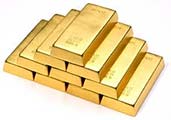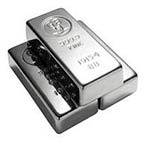
Yellow Gold
 Gold is a very durable metal that will not tarnish or corrode with time. Gold is commonly alloyed with a number of different metals to increase its strength and produce a variety of colors including white, yellow and rose (or pink) color gold.
Gold is a very durable metal that will not tarnish or corrode with time. Gold is commonly alloyed with a number of different metals to increase its strength and produce a variety of colors including white, yellow and rose (or pink) color gold.
Yellow gold alloys include copper, silver and zinc. White gold is created by combining pure gold with copper, nickel and zinc. Pink gold is created by combining larger amounts of copper with pure gold.
White Gold
White gold is an alloy of gold and nickel. Because 14k white gold is 58.3% gold, and 18k white gold is 75% gold, white gold will naturally have an off-white color. To give white gold its brilliant white luster, in the final process of manufacturing, white gold is rhodium plated. Rhodium is a shiny, white metal, which is extremely hard and durable. However, over time the rhodium plating may wear away, revealing the slightly yellowish tint of the underlying metal. To keep white gold looking its best, it may require rhodium re-plating every 1 - 2 years, depending on wear. All white gold jewelry purchased from MoissaniteCo.com is rhodium plated.

Palladium
 Palladium is also a member of the platinum family. Like platinum, palladium is naturally white. Palladium is 10% harder than platinum, and therefore, is more scratch resistant (besides this, the durability of palladium is identical to that of platinum). The color is nearly identical to platinum (slightly whiter). Palladium is many times more rare than platinum and is therefore more precious.
Palladium is also a member of the platinum family. Like platinum, palladium is naturally white. Palladium is 10% harder than platinum, and therefore, is more scratch resistant (besides this, the durability of palladium is identical to that of platinum). The color is nearly identical to platinum (slightly whiter). Palladium is many times more rare than platinum and is therefore more precious.
The main differences between platinum and palladium is the price (which is comparable to 18k gold) and the density/weight which is comparable to 14k and not platinum.
"White" Precious Metals Comparison Chart
Because of the many choices that are available, customers often ask us which metal is the "best"? The answer is that it depends as each precious metal alloy has its own unique properties. We provide the following table to summarize the more important properties of each.
| Weight / Composition | Hardness / Resistance to Scratching | Color | Allergenic | Maintenance | |
| Platinum | 75 - 80% heavier than 14k gold 95% platinum, 5% other |
Scratches easier than 14k and 18k gold and slightly more than palladium | Maintains it's white color forever. The color is darker, more gray, than rhodium plated white gold. | Hypoallergenic | Long term maintenance includes repolishing. Polishing platinum is more labor intensive than gold or palladium alloys. |
| Palladium | Comparable to the weight of 14k gold 95% palladium, 5% ruthenium |
10% harder than platinum, but scratches easier than 14k white gold | Maintains it's white color forever. The color is darker, more gray, than rhodium plated white gold. Very close to the color of platinum. | Hypoallergenic | Long term maintenance includes repolishing. Polishing palladium is more labor intensive than gold, but not as much as platinum. |
| 18k White Gold | 15 - 20% heavier than 14k gold 75% gold, 25% additional metals: zinc, copper, silver, nickel (white gold) |
Softer than 14k gold but harder than palladium and platinum | Will eventually tinge to a very light yellow (requiring rhodium plating) | A small percentage of women (10%) are allergic to the nickel content found in the white gold alloys | Long term maintenance includes repolishing and replating (rhodium finish) |
| 14k White Gold | 58% gold, 42% additional metals: zinc, copper, silver, nickel (white gold) | 14k gold is the hardest and will maintain its high polish the longest | Will eventually tinge to a very light yellow (requiring rhodium plating) | A small percentage of women (10%) are allergic to the nickel content found in the white gold alloys | Long term maintenance includes repolishing and replating (rhodium finish) |
Summary:
- Platinum: the pros are that it is naturally white, hypoallergenic, more pure (95%), and it is noticeably heavier than other precious metals. The cons of platinum is the price which is currently very expensive (more than three times the price of 14k gold). Platinum is the softest of the precious metals, and therefore it scratches the easiest.
- Palladium: the pros are that it is naturally white, hypoallergenic, more pure (95%), and it is substantially less expensive than platinum. The cons are that it is only a little harder than platinum so it will scratch easier than white gold alloys, and it may be a little more difficult to find a jeweler who can work with palladium if you live outside the United States or in a rural area.
- 18k White Gold: the pros are that is more pure than 14k white gold (75% vs 58%), and it is more scratch resistant than palladium or platinum. The cons are: it is softer than 14k white gold, it contains nickel to which 10% of women are allergic, and it naturally has a slight yellow tinge, and so it requires rhodium plating to be pure white in color.
- 14k White Gold: the pros are that it is harder than 18k gold, palladium and platinum, and therefore the most scratch resistant. The cons are: it contains nickel to which 10% of women are allergic, and it naturally has a slight yellow tinge, and so it requires rhodium plating to be pure white in color.
